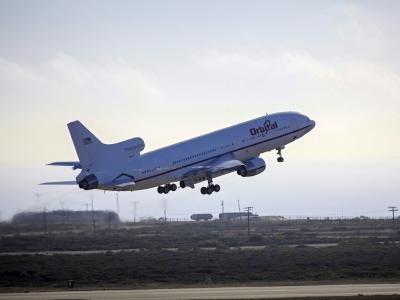Sat, Jun 29, 2013
IRIS Spacecraft Launched From Orbital Sciences Corp Aircraft
NASA's Interface Region Imaging Spectrograph (IRIS) spacecraft launched Thursday at 1927 PDT from Vandenberg Air Force Base, CA. The mission to study the solar atmosphere was placed in orbit by an Orbital Sciences Corporation Pegasus XL rocket. "We are thrilled to add IRIS to the suite of NASA missions studying the sun," said John Grunsfeld, NASA's associate administrator for science in Washington. "IRIS will help scientists understand the mysterious and energetic interface between the surface and corona of the sun."

IRIS is a NASA Explorer Mission to observe how solar material moves, gathers energy and heats up as it travels through a little-understood region in the sun's lower atmosphere. This interface region between the sun's photosphere and corona powers its dynamic million-degree atmosphere and drives the solar wind. The interface region also is where most of the sun's ultraviolet emission is generated. These emissions impact the near-Earth space environment and Earth's climate.
The Pegasus XL carrying IRIS was deployed from an Orbital L-1011 carrier aircraft over the Pacific Ocean at an altitude of 39,000 feet, off the central coast of California about 100 miles northwest of Vandenberg. The rocket placed IRIS into a sun-synchronous polar orbit that will allow it to make almost continuous solar observations during its two-year mission.
The L-1011 took off from Vandenberg at 1830 PDT and flew to the drop point over the Pacific Ocean, where the aircraft released the Pegasus XL from beneath its belly. The first stage ignited five seconds later to carry IRIS into space. IRIS successfully separated from the third stage of the Pegasus rocket 1940. At 2005 PDT, the IRIS team confirmed the spacecraft had successfully deployed its solar arrays, has power and has acquired the sun, indications that all systems are operating as expected.
"Congratulations to the entire team on the successful development and deployment of the IRIS mission," said IRIS project manager Gary Kushner of the Lockheed Martin Solar and Atmospheric Laboratory in Palo Alto, Calif. "Now that IRIS is in orbit, we can begin our 30-day engineering checkout followed by a 30-day science checkout and calibration period."
IRIS is expected to start science observations upon completion of its 60-day commissioning phase. During this phase the team will check image quality and perform calibrations and other tests to ensure a successful mission.
(Image provided by NASA)
More News
Say Altitude Used by ATC to ascertain an aircraft's specific altitude/flight level. When the aircraft is climbing or descending, the pilot should state the indicated altitude round>[...]
Aero Linx: European Air Law Association (EALA) EALA was established in 1988 with the aim to promote the study of European air law and to provide an open forum for those with an int>[...]
From 2023 (YouTube Version): The Life, Death, Life, Death, and Life of a Glorious Warbird In 1981, business-owner Jim Tobul and his father purchased a Chance-Vought F4U Corsair. Mo>[...]
Also: USCG Retires MH-65 Dolphins, Irish Aviation Authority, NATCA Warns FAA, Diamond DA42 AD This summer, history enthusiasts will have a unique opportunity to experience World Wa>[...]
Also: WACO Kitchen Bails, French SportPlane Mfr to FL, Dynon-Advance Flight Systems, Innovation Preview Bobby Bailey, a bit of a fixture in sport aviation circles for his work with>[...]
 ANN's Daily Aero-Term (05.01.24): Say Altitude
ANN's Daily Aero-Term (05.01.24): Say Altitude ANN's Daily Aero-Linx (05.01.24)
ANN's Daily Aero-Linx (05.01.24) Classic Aero-TV: Korean War Hero Twice Reborn
Classic Aero-TV: Korean War Hero Twice Reborn Airborne 04.29.24: EAA B-25 Rides, Textron 2024, G700 Deliveries
Airborne 04.29.24: EAA B-25 Rides, Textron 2024, G700 Deliveries Airborne Affordable Flyers 05.02.24: Bobby Bailey, SPRG Report Cards, Skydive!
Airborne Affordable Flyers 05.02.24: Bobby Bailey, SPRG Report Cards, Skydive!



